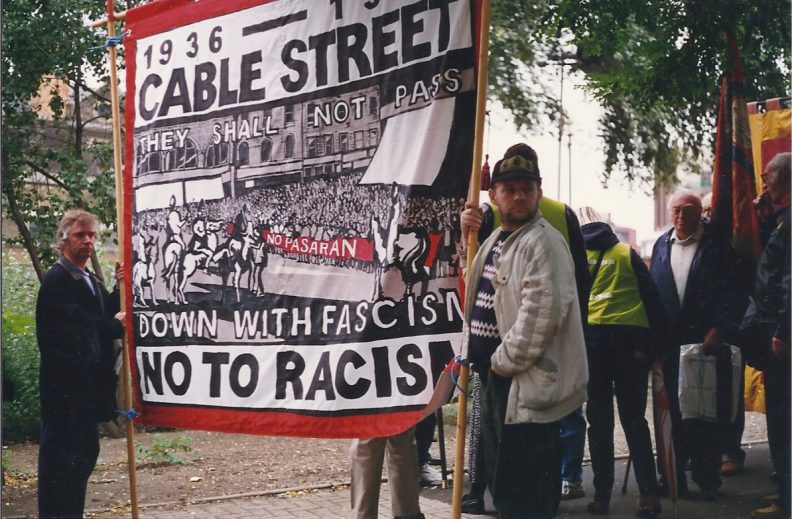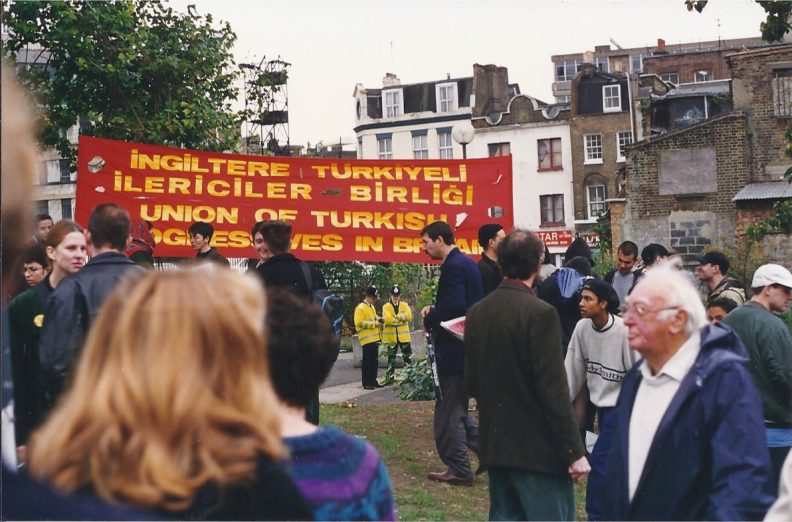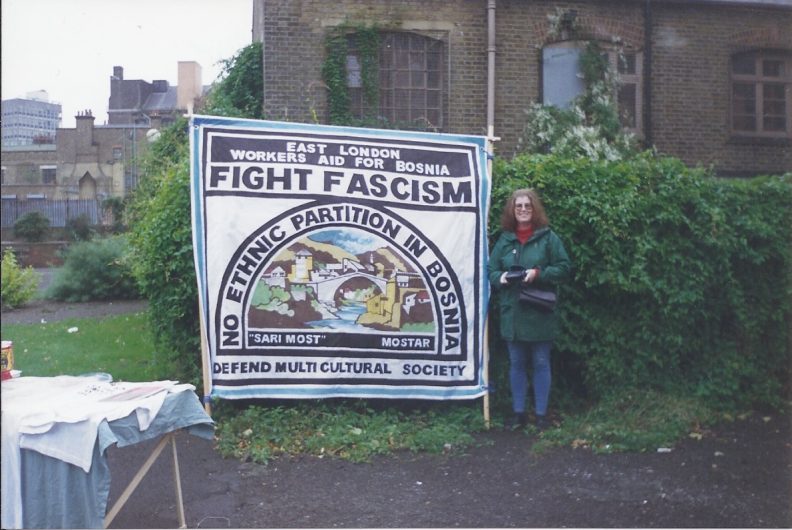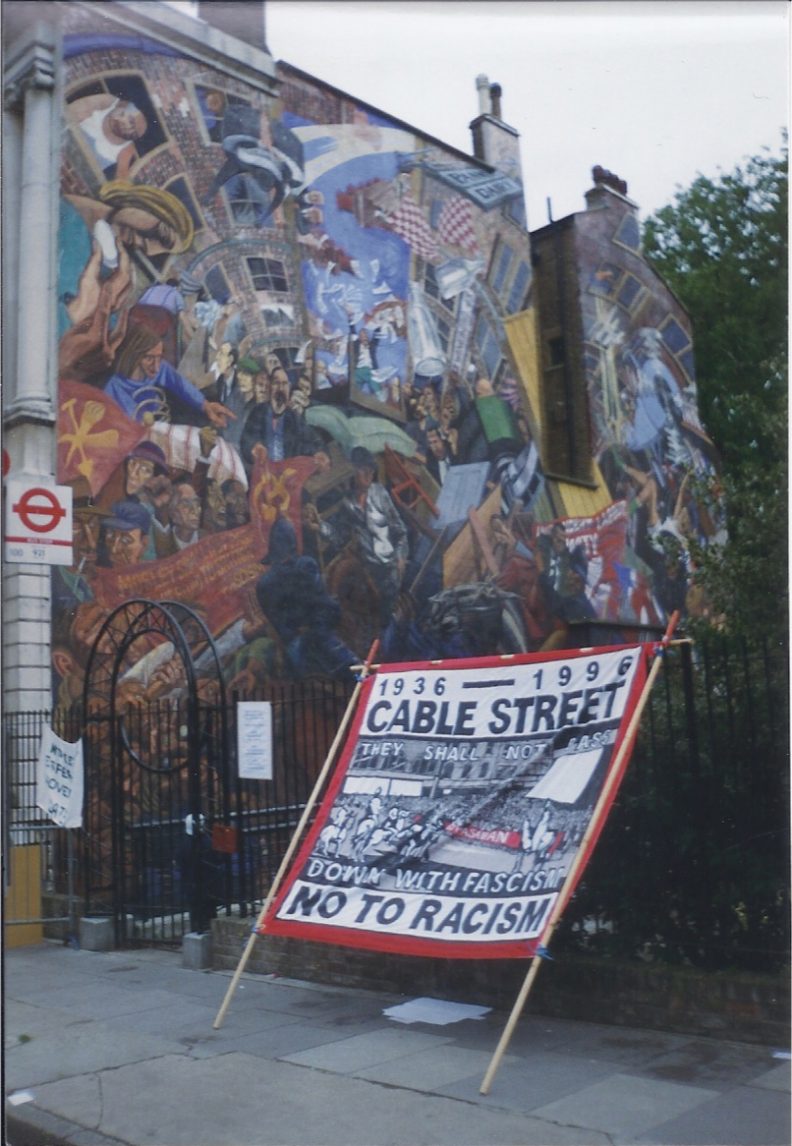Next month we will remember those anti-fascists who in their ten of thousands prevented the march of Sir Oswald Mosley’s Blackshirts of the British Union of Fascists and National Socialists into the heart of the Jewish working class borough of Stepney (now Tower Hamlets).
We also salute those of them who went on to defend the republican government of Spain. Many never returned, many came back with serious wounds, and of the rest, many were among the first to join up even before the outbreak of the Second World War to once again take the fight to the Nazis and Fascists.
Since the defeat of Nazi Germany and its allies, the overthrow by the Italian people of Mussolini and the victory over Japanese fascism, successive generations have stood up against fascism, Nazism, religious intolerance and racism in postwar Britain.
The East End of London has remained in the front line against a succession of postwar enemies of democracy from Mosley’s failed attempt to return to openly Nazi groups that killed black Britons and carried out attacks on the Jewish community. The fight continues today against groups that promote the sort of hatred that murdered the Labour MP Jo Cox as part of their war against the Muslim community.
Tower Hamlets has stood firm against failed attempts by the English Defence League to stage symbolic marches where Mosley had failed.
It is the duty of all of us to show respect for our dead heroes and say that from 1936 until 2016 they have still failed to pass.
Below we reproduce a press release from Cable Street 80, the organisers of this year’s 80th anniversary commemoration of the Battle of Cable Street. Afterwards follows an article by Philip Edwards which recalls the 60th anniversary celebration. Details of the 80th anniversary commemoration are here.
Cable Street 80 – a weekend to remember
On Sunday 9 October people will join a march and rally in London’s East End to celebrate the 80th anniversary of the defeat inflicted on Sir Oswald Mosley’s British Union of Fascists in 1936. This is the culmination of a weekend of events in which veterans of the Battle of Cable Street will join today’s campaigners and residents to remember the determination and solidarity of the hundreds of thousands of people who put up barricades and blocked roads to protect the East End Jewish community from the violence of the Blackshirts.
The march is organised by Cable Street 80, a coalition of Jewish, Bengali and anti-racist organisations. It starts in Altab Ali Park, on Whitechapel Road, named in memory of a young Bangladeshi clothing worker who was murdered by racists in 1978, and ends at St George’s Gardens on Cable Street, where a giant mural depicts the Battle on the side of St George’s Town Hall.
The march assembles at 12 noon at Altab Ali Park, Whitechapel Road on Sunday 9 October. Speakers from many communities and affiliations will address the crowds at Altab Ali Park and the rally at St George’s Gardens. They include 101-year-old Cable Street veteran Max Levitas, newly re-elected Labour leader Jeremy Corbyn, local MP Rushanara Ali, local London Assembly member Unmesh Desai, and General Secretary of the TUC Frances O’Grady.
Cable Street 80 has received strong financial and practical support from the trade union movement. Megan Dobney of South East Region TUC will chair the rally at St George’s Gardens.
Two marching bands – The Great Yiddish Parade and Udichi Bengali musicians – will accompany the event.
The march will be led by representatives of Jewish and Irish organisations, and the Communist Party – representing the main groups that collaborated in the campaign to keep the fascists out of the East End in 1936.
Living memory – but only just
People have gathered every five years since 1986 to recall the collaboration between Jewish, Irish and other East End residents to defend their multicultural community from invasion by the Blackshirts. Some of the men and women who helped deliver this decisive blow to Britain’s homegrown fascists are still here to describe those events, but their numbers are dwindling. This could be our last chance to hear their personal testimony.
Racist and fascist violence continues to rise, here and across Europe. This year, MP Jo Cox was murdered by a man shouting “Britain First” – the motto of Mosley’s Blackshirt newspaper and the name of a current far-right splinter group; Polish people living and working in the UK are being violently attacked; Muslims are routinely threatened and abused; and anti-racists supporting migrants and asylum seekers arriving at Dover have been violently attacked by fascists whose banners proclaim: “Hitler was right”.
Cable Street 80 Convenor David Rosenberg says, “The people made sure the fascists did not pass in 1936. Our march and rally on 9 October has been organised both to honour the past and to unite people across different communities against racism and fascism today, so that fascism will never pass.”
In addition to the march and rally on 9 October, an exhibition about the Battle of Cable Street will open on 28 September and run until 29 October at the Idea Store, Watney Market, 260 Commercial Road, London E1 2FB.
On 8 October from 2.30pm to 4.30pm women veterans of Cable Street will be in conversation with author Kate Thompson at the same venue.
Further details and interviews:
David Rosenberg, Cable Street 80 Convenor at: CableStreet80@aol.com 07876 200267
Rob Griffiths, Cable Street 80 Secretary on: 07790 884137
Visit www.cablestreet80.org.uk for more information

The Cable Street commemoration march (60th anniversary) 1996
By Philip Edwards
I feel I ought to say something about the Cable Street Commemoration march we organised on the occasion of the 60th anniversary of this important event. In the light of the welcome 80th anniversary march perhaps we can draw some lessons from our experiences 20 years ago.
I was secretary of Tower hamlets Trades Union Council in the 1990s. It was an organisation largely kept afloat by the tireless work of a small executive committee with an increasingly broad network of contacts. We set up a Commemoration Committee representing trade unions, campaign groups and left political organisations to bring together as many progressive groups and community activists as possible. In the event the march which was followed by entertainment and speeches in Cable Street, attracted nearly 1,000 participants. Contingents included ELTA (East London Teachers Association), NATFHE (the further education union), various Unison branches, GMB, various Trades Councils, Greater London Pensioners, groups from the organised Turkish community in Hackney and elsewhere, the Connolly Association, Labour Party branches, Unite Against Racism Hackney, Searchlight, the Anti Nazi League, Workers Aid for Bosnia, FBU London Region, SWP, WRP, NCP, CPGB, Communist Party, Refugee Worker Culture Association (Turkish), Newham Monitoring Project, Student Assembly against Racism and countless other anti-racist groups and campaigns from different parts of London and elsewhere, as well as surviving members of the International Brigade (Madrid contingent). It was a mark of the success of the Commemoration Committee that all these different groups marched behind the banner we had made especially for the occasion.

The work for this, however, really began years earlier with our efforts to involve ourselves not just in the growing anti-racist and anti-fascist movement but in the broader trade union movement. It became increasingly clear, especially after the shock election of the first British National Party councillor, Derek Beackon, in the Millwall by-election in Tower Hamlets, that unless we as a movement addressed the issues of education, unemployment, health and, especially in Millwall, housing, we would never win over that section of the working class population that was attracted to the racist rhetoric and actions of the fascists.
Millwall and the Isle of Dogs in 1993 was where an increasing conflict between the growing Bangladeshi community and sections of the white working class was exploited by groups such as the Liberal Focus Group and the BNP. The election of a BNP councillor was immediately followed by a BNP rampage and a series of violent attacks on the Bangladeshi community by groups of racists and organised fascists. Altab Ali Park commemorates the victim of one such attack from an earlier period in 1978 which attracted around 7,000 Bangladeshi youths to a march on Downing Street. In 1994 we saw a repeat of this violence on a broader and more systematic scale by those egged on by the election result.
The Trades Council got involved in some of the groups organising resistance to this growing conflict. The long list of acronyms is testimony to the broad nature of this movement. THARC (Tower Hamlets Anti Racist Committee) coordinated with some of the groups we later tried to involve in the commemoration march of 1996. These included WUAR (Women United Against Racism) THAR (Tower Hamlets Against Racism), CARF (Campaign against Racism and Fascism) , ANL (Anti Nazi League), ARA (Anti-Racist Association) and the Tower Hamlets 9 campaign.
A number of attacks on school pupils was a particular concern in 1994. I was a teacher at Morpeth School when the BNP focussed its attention on leafleting outside the school gates. NUT groups in our school and elsewhere tried to support pupils as they walked through this unpleasant intimidating line of fascists. In one week there was a series of physical attacks virtually every day in the area. Some of these involved armed groups of men with knives and bottles. The victims were often school students and, in at least two serious attacks, students of Tower Hamlets College.
There was a reaction from groups of young Bengalis but unfortunately in one instance, the stabbing of John Stoner, the BNP exploited the situation by feeding the incident into a vindication of the so-called “Rights for Whites” campaign.
We met the TUC and other groups in the community under various umbrellas when a discussion developed about how to address some of the issues raised on the Isle of Dogs while at the same time physically confronting the fascists alongside AFA (Anti-Fascist Action) and the ANL. The Trades Council itself organised a public meeting on the Isle of Dogs to give the local community space to air their grievances. It attracted a small group from the Bengali community and from a white community who said that they were suffering from a housing shortage and felt isolated (echoes of BREXIT here). At the same time the Bengali community felt itself to be under siege. We went on to produce a leaflet entitled “Loaded Dice”, which tried to identify the real causes of the housing shortage, notably the funding crisis created by the Tories and the misappropriation of funding by the London Docklands Development Corporation, which saw “development” along the lines of what we now see in the monstrous megaliths and gated “communities” of Canary Wharf. The EU had directed £19m towards the Enterprise Zone, which pointedly excluded the larger part of Millwall and those areas that had clearly indicated in their desperately misplaced votes a call for their problems to be addressed.
In the end we argued for a march through East London against calls by the TUC for one in Trafalgar Square. The main purpose for us was to illustrate to the Bengali community the strength of the movement behind them while also trying to redress the damage done by the rhetoric of the fascists.
So we arrived in 1996 with a march which not only commemorated the traditions of the struggles of the local Jewish community, Irish, dockers and so forth to confront the police who wanted to open a route for Mosley’s blackshirts through that multi-ethnic community, but to address the new dynamics of this movement of resistance against fascist bigotry in the changed demographics of Tower Hamlets. We were at the same time involved in helping to organise and actively participate in a trade union convoy to Bosnia during the war, with a large van of aid organised with the support of the Greater London Association of Trades Councils. This was to actively strengthen the forces in Bosnia resisting the ethnic cleansing being perpetrated by the Yugoslav People’s Army (JNA) as the former Yugoslavia began to collapse. We also organised a London red bus to transport members of the International Brigade who fought fascism in support of the Spanish Republican government during the Spanish Civil War. Internationalism has to be at the heart of the anti-racist struggle, especially in the current climate of xenophobia represented by Donald Trump and the Brexiteers resisting all aid to the Calais migrants trapped in the “Jungle”. I still feel that the anti-racist struggle needs to address all of these broader social and political questions. The growth of violent racist attacks following Brexit, should be sending another clear message to our movement that we need to fight the fascists and counter the arguments of the racists with an eye on some of these other issues.

In closing I would like to apologise in advance if I have excluded any group which played a role in this struggle at the time. This is not a history, just a few comments on the climate in Tower Hamlets in the years preceding the organised march. The march itself was extremely positive and demonstrated the participation of the broad spectrum of trade unions, campaign groups, left political organisations and sections of the local community which joined it. I hope that the 80th anniversary commemoration is as successful.

